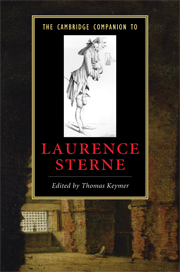Book contents
- Frontmatter
- Introduction
- 1 Laurence Sterne’s life, milieu, and literary career
- 2 Scriblerian satire, A Political Romance, the ‘Rabelaisian Fragment’, and the origins of Tristram Shandy
- 3 Tristram Shandy, learned wit, and Enlightenment knowledge
- 4 Tristram Shandy and eighteenth-century narrative
- 5 The Sermons of Mr. Yorick: the commonplace and the rhetoric of the heart
- 6 A Sentimental Journey and the failure of feeling
- 7 Sterne’s ‘politicks’, Ireland, and evil speaking
- 8 Words, sex, and gender in Sterne’s novels
- 9 Sterne and print culture
- 10 Sterne and visual culture
- 11 Sterne and the Modernist Moment
- 12 Postcolonial Sterne
- Further reading
- Index
- Series List
4 - Tristram Shandy and eighteenth-century narrative
Published online by Cambridge University Press: 28 January 2010
- Frontmatter
- Introduction
- 1 Laurence Sterne’s life, milieu, and literary career
- 2 Scriblerian satire, A Political Romance, the ‘Rabelaisian Fragment’, and the origins of Tristram Shandy
- 3 Tristram Shandy, learned wit, and Enlightenment knowledge
- 4 Tristram Shandy and eighteenth-century narrative
- 5 The Sermons of Mr. Yorick: the commonplace and the rhetoric of the heart
- 6 A Sentimental Journey and the failure of feeling
- 7 Sterne’s ‘politicks’, Ireland, and evil speaking
- 8 Words, sex, and gender in Sterne’s novels
- 9 Sterne and print culture
- 10 Sterne and visual culture
- 11 Sterne and the Modernist Moment
- 12 Postcolonial Sterne
- Further reading
- Index
- Series List
Summary
William Kenrick begins the earliest review of Tristram Shandy, published in the Monthly Review for December 1759, by locating the work in the tradition of novels, and recognising its extended title - The Life and Opinions of Tristram Shandy, Gentleman - as parodying this tradition. 'Of Lives and Adventures the public have had enough, and, perhaps, more than enough, long ago', Kenrick writes: 'A consideration that probably induced the droll Mr. Tristram Shandy to entitle the performance before us, his Life and Opinions.' Numerous books of fiction with Life and Adventures in the title had indeed been published by this time, more if we include such instances as The Life and Strange Surprizing Adventures of Robinson Crusoe (1719). Sterne plays on the expected formulas of a new but already familiar genre, and Kenrick finds him, as the review concludes, 'infinitely more ingenious and entertaining than any other of the present race of novelists'. The title of Tristram Shandy, in which a romance given name is undercut by a commonplace, even comic or satirical, surname, had other kinds of precedent in recent fiction. Alongside such examples as Roderick Random (1748), Peregrine Pickle (1751), and Ferdinand Count Fathom (1753), all by Tobias Smollett, Tristram Shandy could invite identification as a related kind of novel, though Smollett's Life and Adventures of Sir Launcelot Greaves - serialised in monthly magazine instalments and sporting, like Sterne's more leisurely serial, the name of an Arthurian knight - only started to appear in January 1760, when Sterne had already published his opening volumes.
- Type
- Chapter
- Information
- The Cambridge Companion to Laurence Sterne , pp. 49 - 63Publisher: Cambridge University PressPrint publication year: 2009
- 1
- Cited by

